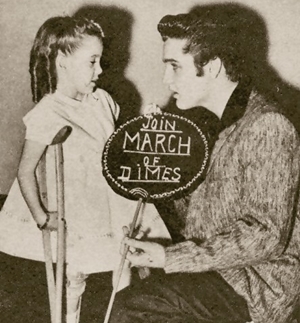Joanne Kelly, the March of Dimes poster girl who met (and kissed) Elvis, talks to EIN
Interview by Nigel Patterson - 2007 |
This photograph will bring back a lot of memories for many long time fans. In 1956-57 Elvis helped promote polio vaccinations for the March of Dimes (MOD). He was photographed with the organisation's poster girl, Joanne Wilson, and also having his polio vaccination.
Subsequently, Elvis' "Love Me Tender" and an interview were featured on the 1957 LP, Remember Me! March of Dimes 1957 Galaxy of Stars. The LP is now a rare collector's item.
But whatever happened to the little girl who was lucky enough to meet and kiss Elvis?
Well EIN has tracked her down and we recently had the pleasure of talking to Joanne Wilson (married name Kelly) in a very entertaining and informative interview. Joanne opens up about her exciting time as the MOD poster girl meeting not only Elvis, but many other big name celebrities and tells us what she is doing in 2007.
|
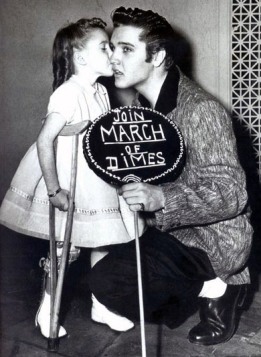 |
EIN: Joanne, it's great to talk with you. Many long time fans will remember the photo of you and Elvis and I'm sure many have wondered whatever happened to the girl in the photo.
Ouside of the USA many fans will not really know what the March of Dimes organisation is about and all the good work it does. Please tell us about its role when you were its poster girl.
JK: A good way of telling your readers about March of Dimes is to reproduce the following excerpt from its website:
The March Begins - The nationwide crusade against poliomyelitis (polio) began at Warm Springs, Ga., a spa where Franklin D. Roosevelt first went in 1924, seeking the therapeutic effects of the warm spring waters. Other polio victims followed his example. In 1926, Roosevelt purchased the whole property and, a year later, with the help of his former law partner, Basil O'Connor, established the nonprofit Warm Springs Foundation.
During the Great Depression, the Georgia Warm Springs Foundation, in need of funds, started to appeal to the general public. Initially, money was raised through an annual "President's Birthday Ball," with FDR and a variety of celebrities participating.
In January 1938, alarmed by decades of worsening polio epidemics and the terrible toll the virus was taking on America’s young, President Roosevelt established the National Foundation for Infantile Paralysis. The National Foundation emphasized the nationwide significance and non-partisan character of the polio crusade. FDR believed that people could solve any problem if they worked together. Comedian Eddie Cantor coined the phrase "March of Dimes" (playing on the popular newsreel feature "The March of Time"), appealing to radio listeners all over the country to send their dimes directly to the White House. The campaign proved to be hugely successful. The National Foundation officially changed its name to the March of Dimes in 1979.
The Search for a Vaccine - Over the next 17 years, the National Foundation focused on funding research to develop a vaccine against polio. While researchers worked tirelessly in their labs, volunteers helped polio victims and their families around the country. In 1948, with funding provided by the March of Dimes, Dr. Jonas Salk was able to grow the three known types of polio virus in his lab and eventually to develop an experimental killed-virus vaccine.
In the summer of 1952, Dr. Salk tested the vaccine on children who'd already recovered from polio. Following vaccination, the level of polio antibodies in their blood increased. The next step was to try it on volunteers who had not had polio–including himself, his wife, and the couple’s children. The volunteers all produced antibodies; none got sick.
The following year, Salk’s initial findings were published in The Journal of the American Medical Association. In 1954, nationwide testing of the vaccine commenced. Nearly 2 million school children, America's Polio Pioneers, took part in these field trials, the largest peace-time mobilization of volunteers in U.S. history. The results of these field trials were clear. Statistics showed that the Salk vaccine was 80-90 percent effective in preventing polio. In the next four years, 450 million doses of the vaccine were administered and it became a standard fixture among childhood immunizations. Later, in 1962, an oral polio vaccine, developed by Dr. Albert Sabin, with funding from the March of Dimes, was licensed.
A Unique Place in History - The March of Dimes occupies a unique place in American history. Its efforts to provide care for the victims of polio while aggressively working to develop vaccines against it, represents the first large-scale, nationwide biomedical initiative, led by a charitable organization. It also helped make the volunteer movement an integral part of the fabric of American life.
Before the development of the polio vaccines, an estimated 50,000 people in the United States were affected by polio each year. As a result of March of Dimes efforts, virtually all babies now receive the Salk vaccine to prevent polio and there has not been a new case of the disease in the Western Hemisphere since 1991. In 2001, the World Health Organization reported just 480 cases of polio worldwide and hopes to declare the world polio-free by 2005.
Opposite: Elvis receiving his polio vaccination |
 |
In collaboration with the Warm Springs Institute for Rehabilitation, March of Dimes Global Programs co-sponsored a symposium on post-polio syndrome (PPS) at Warm Springs, Georgia on May 19-20, 2000. More than 20 experts from five countries presented information at the symposium. Two reports derived from the conference: a primer for medical care providers on best practices in diagnosis and care; and a brochure for polio survivors that provides similar information in lay terms. Both reports have been published and widely distributed through the assistance of the International Polio Network, a St. Louis-based organization that assists and coordinates information for post-polio support groups. In addition, the American Academy of Neurology is working closely with the March of Dimes, in cooperation with the American Academy of Physical Medicine and Rehabilitation and several allied health care professional organizations, to develop practice guidelines for PPS.
Since 1958, the March of Dimes has been funding cutting edge research and innovative programs to save babies from birth defects, premature birth and low birthweight.
EIN: The role of the March of Dimes organisation has changed since the 1950s. What is its main roles or roles today?
JK: Today the MOD raises money for research into Birth Defects. A lot of polio survivors are disappointed that they aren't much help to those of us who now have come down with Post Polio Syndrome. We need to go back into braces and use motorized wheelchairs and that's expensive.
EIN: How prevalent in the US today are diseases such as polio?
JK: There are still outbreaks of polio in the USA today! There are cults/communes/sects who don't believe in immunization and there have been cases of polio out west.
EIN: It must have been a real honor being the March of Dimes poster girl. How did you become the poster girl?
JK: I was 18 months old when I caught the polio virus. It was the summer of 52. I was put in isolation for 3 weeks and then spent the next nine months in the hospital's nursery. My crib was at the end of the large room and in the corner.
One day several debutantes, one of whom was Maria Riva, Marlene Dietrich's daughter, visited. They were doing charity work for the MOD (March of Dimes) and came into the nursery. I was a bit of a tomboy so I bounced up and down calling and waving to them. They were looking for a child who smiled a lot and I fit the bill. They asked my Mom if I could pose for pictures to raise money for research on the polio vaccine. The only reason she agreed was because the pictures would be taken outside of the hospital and my Mom would be able to hold me and dress me in regular clothes.
Back then, visiting hours for parents were for one hour on Sunday. Your parents had to wear a white gown, mask and hat and were told to keep their hands off. My parents were also grateful the MOD because they paid for everything.....surgeries, braces, crutches etc..
EIN: And for how long were you the poster girl?
JK: I was around two years old when I started. I was a poster child from 53-59. After the vaccine came out, they used my pictures to persuade other parents to get their children immunized.
EIN: Being the March of Dimes poster girl must have been a very exciting time for you. What were your main duties as poster girl?
JK: My main job was to smile and look happy when they wanted me too and also look sad when they wanted me too. The shoots always went fast so the photographers started to ask exclusively for me. My pic was in every NYC paper. I was on the Ed Sullivan show a couple of times and also the Sid Ceasar show. I've posed with Eleanor Roosevelt, Dr. Salk, Jack Benny, Otto Preminger, Tab Hunter, Elvis, Eddie Fisher, Michael Wilding, and lots of other radio, movie and tv celebrities. I had signed photos but they were stolen years ago. I do have some copies but they are unsigned.
EIN: And meeting Elvis, what do you remember about that? Were you excited?
JK: Not really. LOL I was around 6 or 7. I never knew who these people were. I just smiled for them. I liked to hang out with the elevator operators, the cooks in the kitchen or ride up and down on the camera dollies. I was an imp! Ed Sullivan gave me his dressing room to take a nap in. He really wanted me safely tucked away cause there were cables all over the studio floor and he was worried I'd fall.
EIN: Were you an Elvis fan when you met him?
JK: No and I didn't want to kiss him!! LOL Of course I never said anything and puckered up when the shot was taken. There's another pic of both of us licking the lollipop. I didn't get to take the huge lollipop home but I usually was given a doll or some toy to take home. My parents weren't fans either but Elvis spent over an hour with them. He offered all sorts of things to help me but my parents always refused these offers. They said he was the nicest celebrity they had ever met and Elvis was one of the last shoots I did because I was in school by then and my parents didn't want me to miss class.
When Eddie Fisher wanted to send a truck from FAO Swartz filled with toys and they said no. He spent a lot of time playing and singing for me. He put me up on a piano and when he finished each song, he'd ask who my favorite singer was. I told him over and over that it was Perry Como! ROFL Como was on TV early and Eddie Fisher's show was after I was in bed. |
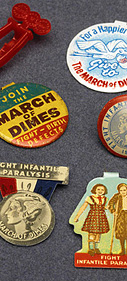 |
Otto Preminger offered to put me in a movie. He promised that I wouldn't be filmed walking, just sitting on a train and I would get royalties. They said no to that too. The MOD never filmed us walking. When I appeared on TV, I came out on stage during the commercial break and stood next to the mike. Sid Ceaser was drunk and forgot who I was and what I was there for! LOL I asked him to lean over and I whispered to him "I'm Joanne. I have polio and I want some dimes." I had this plastic can and collected dimes from anyone I met.
EIN: How was the meeting arranged with Elvis' management?
JK: You'd have to ask the MOD about that. Both my parents have passed. I do know that the pic was taken on the afternoon of the day he appeared on Ed's show. He sang "You're Nothing But A Hound Dog." He was very young. I closed my eyes when I kissed him.
EIN: How did other young people react when they found out you had met Elvis?
JK: My relatives were impressed but the kids my age weren't buying records so he was just another reason I missed school to them.
EIN: Given many parents were against Elvis at the time, what did your parents think of you meeting him?
JK: My parents were surprised at how wonderful he was to them. Many other celebrities just show up for the pic and rush out as soon as they can. They said he seemed very concerned about my welfare and asked many questions about the surgeries I had had and what my future would be like.
EIN: What is your favorite Elvis song?
JK: Love Me Tender
EIN: And your favorite Elvis film?
JK: Jailhouse Rock
EIN: Did you ever get to meet Elvis again?
JK: No, I didn't. I never thought at 13 to contact Ed Sullivan when he had the Beatle's on. I'm sure he would have remembered me and I was a big Beatles fan.

EIN: As the March of Dimes poster girl you met many celebrities. Apart from Elvis who are some of your other memories?
JK: I could write a book! LOL When I was 4, I took my 2 year old sister out of the backyard and down the block to the local courthouse. I climbed two stories up on the prisoner's cage behind the courthouse and was leaning over instructing my sister how to stick her shoes in the fence to climb up when the van came to unload the prisoner's. The guards wouldn't let me climb down and we were both carried home. My Mom hid my brace as punishment.
When I was 9, I "escaped" from the hospital in a wheelchair by using the freight elevator. I made it uphill for two blocks before running into some nurses coming out of a coffee shop. That cost me 3 days tied up in bed. I am responsible for there being a lock on the doors to the roof and the PT pool in the hospital. We had a play yard up on the roof and I liked to yell to Frank Sinatra and Mia Farrow when I saw them on their terrace. They waved but never came over to visit. I tried to sneak into Kennedy's room when he had his back operation but couldn't get past the guards.
I organized wheelchair races in the hospital and there was only one other person who ever beat me. He was older and had long arms. I also ran a secret little store out of my suitcase when I was a teenager to make a little extra money to make phone calls. I sold candy and chips (crisps).
EIN: Are you still involved with March of Dimes in 2007?
JK: No. I asked for a copy of my picture with Elvis and they will send it to me for $50.00.
EIN: You are now an adult and married? What are you doing in 2007?
JK: I met my husband Kevin when we were both 19. He was a beach lifeguard and I was the First Aid girl for the NYC Parks Dept. We've been married for 34 years this past July 29th and have a 31 year old son. I taught severely disturbed special Ed students in the NYC Public School system for 28 years and retired in 2000 because of Post Polio. |
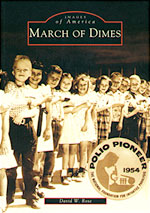 |
Kevin retired in 2003 from the FDNY. He was a Lieutenant in Engine 264. The sister I took to the courthouse worked for US Customs at the World Trade Center. She was missing all day but was found that night. She'll never be the same. Kevin knew over 100 guys who were murdered that day. There were 75 lost from my neighborhood alone. I knew 8 personally and still can't really talk about it. Then four months later, a plane outta JFK, crashed in my neighborhood and I lost another friend and her son who were home that morning. Fughedaboudit.
EIN: Do you have children of your own? (and if yes), how do they react to knowing their mom met Elvis, one of the world's greatest icons?
JK: Yes, Kevin Seamus. His college roommates told him we were cool cause I went to Woodstock in 69. I came out on an Elvis trading card and he showed all his friends. I carry that card with me cause I meet a lot of Elvis fans who love to look at it and hear about how nice he was.
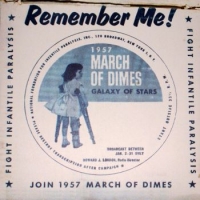
The very rare "March of Dimes" 16" LP featuring among others, Elvis singing Love Me Tender and also being interviewed (a 12" vinyl re-issue was released in early 2007)
EIN: Joanne, is there anything else you would like to say to our readers?
JK: Elvis will always be the King! I've never been to Graceland but my cousin has. He said that there is a room devoted to all Elvis' charitable works. My picture is behind a glass case. He also did a lot for the American Heart Association. I saw my pic at the beginning of a show about Elvis and Gospel music that was on cable TV. Sometimes, around Elvis' birthday one of my pics appear in a newspaper.
Hopefully, my future will allow me to continue to travel. I took up the tin whistle in 2000 and Kevin plays the Bodhran and Bones. He started playing in 98 but it was the 2 years after 9/11 when he really excelled. He found that practicing had a calming effect on him. We spend a few months each spring now in Ireland. Friends lend us their cottage in Mullagh, Co. Clare.
Our friends in Ireland were misinformed and thought Kevin had died on 9/11. Four other firefighter's who were killed were also named Kelly. They had a wake for him in Kinsale! When he came over the next year, they made him drink whiskey to celebrate. A woman also planted 343 trees with the name of each firefighter lost on each tree. So sad to walk around looking for the names of loved ones lost.
Kevin knows and plays with professionals like Johnny Ringo McDonough, Tommy Hayes, John Joe Kelly, Joanie Madden, Liz Kane and Mel Mercier but I'm only an intermediate. I do play in sessions in Ennis, Miltown Malbey and Doolin so maybe we'll meet someday! I wear a brace and use red crutches and a red travel battery powered scooter.
EIN: Joanne, thank you very much for talking with us. We wish you all the best for the future.
EIN Note: Elvis continued his association with the March of Dimes organisation. He donated a "signed" jacket he wore in King Creole to the organisation and while In Germany, he and actress Vera Tschechowa, were photographed with then March of Dimes poster boy, Stephen Parquett. In 1964 Elvis purchased Franklin D. Roosevelt's 165-foot long yacht, "The Potomac" at auction...subsequently donating it to the March of Dimes.
|





